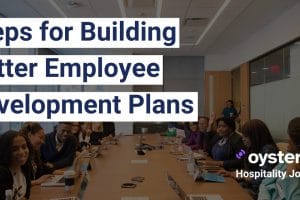In a busy restaurant, timing isn’t just about delivering dishes on time — it’s about making the whole operation run like clockwork. Busy hours are the ideal time to maximize profits and customer satisfaction.
In this guide, we’ll share tips on time management for busy restaurant owners and managers to help them make peak times more manageable. Then, we’ll look at when restaurants typically experience the most traffic throughout the year, week and day.
7 Time Management Tips for Busy Restaurants
Here are some strategies Restaurant Managers and owners can use to better manage a restaurant’s busy times:
1. Use Smart Scheduling to Match Staff With Demand
One of the biggest game changers in managing busy times is scheduling the right staff at the right times.
By analyzing past traffic trends, you can assign more staff to cover peak times and let a lighter crew handle slower hours.
You can take advantage of various tools (such as Google’s popular times data and 7shifts to keep track of busy days and create schedules quickly) to ensure the restaurant is neither over nor understaffed.
Matching staff with demand doesn’t just improve service quality — it also boosts employee morale, as they’re not overwhelmed during rushes or left idle during slow periods.
Need to hire staff for your restaurant?
Post Jobs for FreeLooking for high-paying restaurant jobs?
Find Jobs Here2. Keep Ordering Simple and Quick
Digital ordering systems, such as tableside tablets or QR code menus, can cut down wait times and reduce ordering errors. This is especially beneficial during peak hours when accuracy and speed are critical.

Streamlined order-taking also allows staff to spend more time attending to guests instead of manually writing orders, which can keep things running smoothly when the place is packed.
Again, you can take advantage of various tools and software to make this happen. Some popular tools and software include:
3. Batch Process To Streamline Kitchen Orders
Batch processing orders in the kitchen can make a huge difference during high-traffic periods. This approach involves grouping similar orders (such as grilled items, fried food, pasta dishes and breakfast items) together to prepare them in a single, efficient batch.
As a result, wait times are minimized, ensuring dishes are served hot and fresh. For instance, if several tables order the same popular dish, the kitchen staff can cook multiple portions simultaneously.
Implementing batch processing can be aided by kitchen display systems (KDS) that organize orders by dish type and prioritize them based on service time. Some popular KDS tools include:
Batch processing not only speeds up service during busy times but also reduces stress for kitchen staff, as they work more systematically. When orders are managed this way, staff can focus on quality, avoid bottlenecks and ensure a consistent pace, even when the kitchen is at its busiest.
See also: Effective Strategies for Managing a Restaurant Kitchen
4. Maximize Reservations and Seating Efficiency
Effective table management is key for balancing reservations and walk-ins. You can use advanced table management software so your Host/Hostess can monitor table availability in real-time.
This will allow them to seat guests and prevent overcrowding at the entrance. As a result, it will maximize the number of guests you serve, reduce wait times and improve the overall dining experience.
Some recommended tools include:
5. Stock Up Smartly and Manage Inventory for Peak Demand
Poor inventory management is one of the top reasons for restaurants running out of business.
Not only that, but running out of a popular menu item during rush hour can disrupt service flow and disappoint customers. A disappointed customer is not a returning customer.
Having said that, you need to track inventory closely and use forecasting tools to stock up on the right ingredients to meet demand without over-ordering. This keeps the kitchen well-supplied and cuts down on waste, contributing to a smoother overall operation.
Below, we list the most popular inventory tracking and forecasting software for restaurants:
6. Communication and Training To Keep Everyone on the Same Page
Strong teamwork and clear communication are key during busy hours. Pre-shift huddles, weekly meetings and cross-training are practical ways to keep everyone aligned:
- A quick pre-shift huddle ensures staff know about daily specials, reservations or menu changes.
- Weekly meetings allow team members to discuss feedback and what can be improved
- Cross-training, where staff learn each other’s roles, fosters mutual respect and adaptability. For example, Servers can learn bar or kitchen basics to better communicate with customers regarding menu items.
Then, you can have regular staff training on menu updates, customer service standards and emergency procedures to ensure that every team member is prepared.
Establishing service standards is key to consistently good customer experiences. The “10-5-1 Rule,” for example, is something that can help you and your staff do so — especially during peak shifts:
- Staff make eye contact when customers are within 10 feet
- Greet customers when they’re within five feet
- Check in on customers within one minute after they’re seated
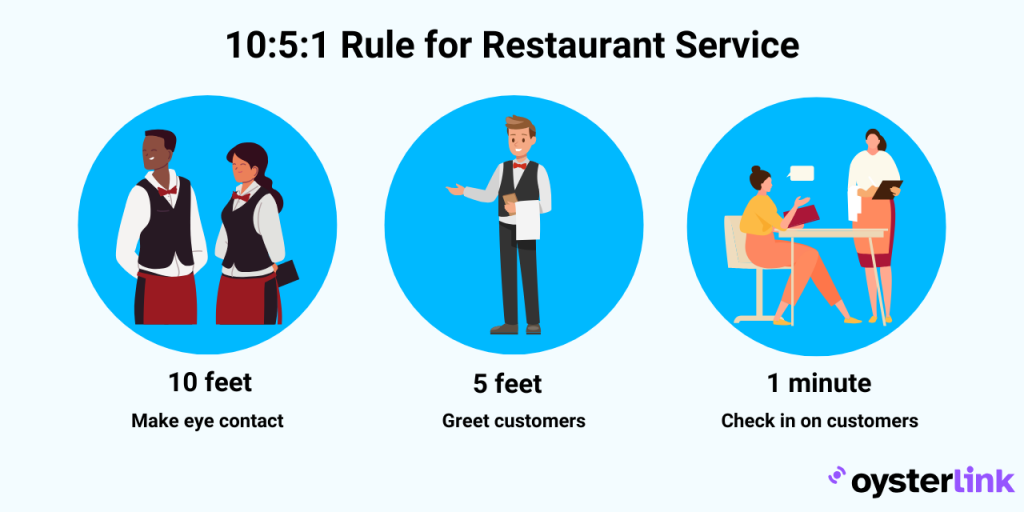
7. Know Your Peak Times to Ensure Preparedness
Knowing when your restaurant’s traffic spikes will help you take advantage of everything we discussed so far. The peak times of your restaurant may depend on various factors, such as type, location and audience.
Below are just some examples of how these factors can play a role in the peak times of your restaurant:
Type of restaurant
- Fast-casual restaurants typically experience peak times during lunch hours, especially between 11 a.m. and 2 p.m., as office workers and students seek quick meals. Dinner rushes are common too, but usually shorter and more manageable.
- Fine dining restaurants often see peak times during dinner hours, generally from 6 p.m. to 9 p.m. This is because most patrons prefer evening meals and leisurely dining experiences.
- Breakfast and brunch cafes have peak times between 8 a.m. and 11 a.m., particularly on weekends, when people seek a relaxed breakfast or brunch outing.
Location
- Restaurants in business districts are busiest during weekday lunch hours, as employees step out for quick lunches. Friday evenings can also draw after-work gatherings.
- Tourist areas and beachfronts tend to see a steady stream of customers throughout the day. Surges tend to occur around lunchtime and dinner, especially during holiday seasons and weekends.
- Suburban neighborhoods may experience family-oriented peak times. This includes early evening dinners around 5 p.m. to 7 p.m. and weekend brunch rushes as locals enjoy a casual outing.
Audience
- Young professionals and office workers often contribute to a lunch rush from 12 p.m. to 2 p.m. They may also bring a dinner crowd on Friday and Saturday evenings.
- Families with children might favor early dinners, around 5 p.m. to 7 p.m., especially on weekends, to accommodate young kids’ schedules.
- College students are likely to show up for late dinners and even post-dinner snacks. This makes evenings from 8 p.m. to 10 p.m. busier, especially in areas close to universities.
Planning ahead can prevent long wait times and overwhelmed staff. By preparing for these high-traffic periods with smart scheduling, streamlined ordering and inventory management, you’ll ensure smoother operations and a better experience for your guests.
Below, we talk about the typical peak times for most restaurants based on the time of year, week and day.
Peak Times for Restaurants Throughout the Year
Understanding the yearly flow of busy and slow seasons can help a restaurant adjust staffing, marketing and inventory needs.
Here’s a breakdown of the busiest seasons for most restaurants:
Summer: Warm Weather, Outdoor Dining and Tourism
Summer months are usually the busiest months for restaurants in many parts of the United States. The main reason for this is good weather that entices people to get out of their homes.
Depending on the location of the restaurant, this period can range from April to September in places with a warmer climate (think Miami) or May to August in places with a colder climate (think New York City).
Additionally, tourism peaks during these months. This is especially true for coastal or popular vacation destinations like NYC, Los Angeles and Miami, which can significantly boost customer flow. A testament to this is the fact that restaurants typically add around 500,000 seasonal jobs, according to the National Restaurant Association.
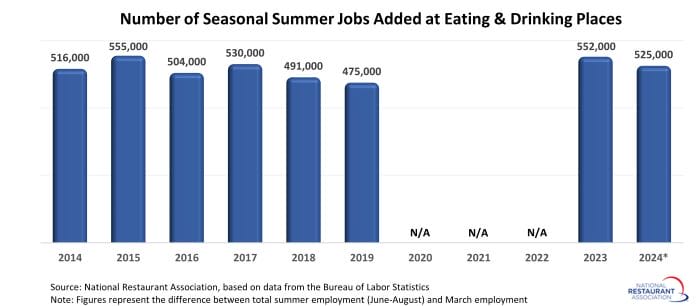
[Source: National Restaurant Association]
To make the most out of the warm weather, you can set up shaded outdoor seating and add themed nights, like seafood or barbecue, to create a lively atmosphere that draws in both locals and tourists.
You can also extend happy hours to take advantage of longer days. Offer refreshing drinks like sangrias and mojitos, paired with light appetizers can attract after-work crowds.
Finally, update your menu with light, seasonal items like fruit sorbets, berry parfaits and salads featuring heirloom tomatoes. These summer specials can enhance the dining experience and keep customers coming back for the best seasonal flavors.
December: The Holiday Rush
December is another busy time for restaurants, thanks to holiday gatherings, company parties and celebratory dinners.
As families and friends come together for festivities, dining out becomes a favorite way to celebrate. A survey from the National Restaurant Association shows that 63% of adults plan on eating out during the holiday season and 48% plan to order takeout or delivery.
That said, restaurant owners, managers and Chefs should consider stepping up their game when coming up with deals and events and planning their main course menu. The reason for this is because customers are becoming more value-conscious.
See also: The Best Seasonal Jobs That Pay Well
Special Days: Mother’s Day, Valentine’s Day and Father’s Day
Certain holidays create spikes in restaurant traffic. Mother’s Day is often the busiest day of the year for many establishments as many people are looking to treat their moms and wives to a nice dinner out.
According to the National Restaurant Association, 53% of people said that they’ll be having dinner in a restaurant on Mother’s Day. Meanwhile, 43% said they’ll dine out for lunch instead.
Valentine’s Day and Father’s Day also see similar bumps, driven by the tradition of celebrating these occasions with a nice meal.
Planning special menus, promotions or booking incentives for these days can help restaurants make the most of the rush.
Weekly Patterns in Restaurant Traffic
Knowing what to expect throughout the week lets you fine-tune staffing, ordering and even marketing.
Let’s break down a typical week in the restaurant business:
Monday–Thursday: The Slower Days
Weekdays, especially Mondays and Tuesdays, are typically quieter. After the weekend, many diners prefer staying home or ordering in, which is why some restaurants even choose to close on these slower days.
However, that doesn’t mean you can’t take advantage of this, especially if your operational budget allows it.
Offering midweek specials or happy hours can help draw in a crowd when the natural foot traffic is lower. Capitalizing on a midweek lunch crowd in business districts, for example, can turn these days into steady earners.
Friday–Sunday: The Lively Weekend
Once Friday hits, restaurants tend to see a big jump in traffic. After the workweek, people are more inclined to enjoy a night out. This surge generally carries through Sunday.
Sundays are often popular for brunch and family meals, with steady foot traffic staying throughout the day. This weekend bump means restaurants need to be fully staffed and prepped to handle large groups and fast turnarounds.
According to Restaurant Life, Friday through Sunday typically drives the highest sales. Anticipating these weekend spikes and preparing the team with efficient service protocols can help maximize profit and prevent burnout.
Daily Rush Hours in Restaurants
Understanding daily peaks means a restaurant can prep ingredients, stock supplies and set up the team for success. We recommend setting up a Google Business profile for your business if you haven’t already. That way, you can track the busy periods using their popular times, wait times and visit duration data.
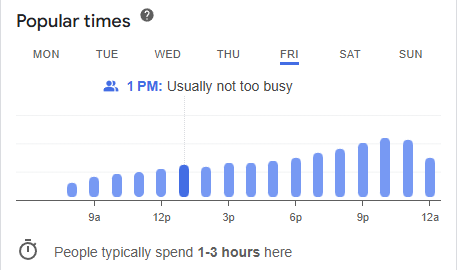
[Source: Google]
However, Google’s data is dependent on customers having their location and internet connectivity being turned on, so it doesn’t always provide the most accurate representation of a restaurant’s business.
That being said, here are the (usually) busiest hours for most restaurants:
Brunch: Late Mornings and Early Afternoons
Brunch has gained massive popularity, especially on weekends. Brunch hours typically start around 10:00 a.m. and last till 2:00 p.m.
This hybrid meal attracts customers looking to relax and enjoy a leisurely experience, often with friends and family.
According to a report by Restaurant Dive, breakfast chains are booming thanks to the rise of “brunch culture.”
But any restaurant can take advantage of this by setting up a specific brunch menu or promoting special drinks during these hours.
Lunch: Office Crowds and Quick Bites
Lunch generally falls between 11:00 a.m. and 3:00 p.m. Restaurants located in business districts and high-traffic tourist spots can make a lot of money during this time frame.
Office workers, professionals and tourists often look for quick meals. Fast-casual and quick-service restaurants, in particular, benefit from this midday rush.
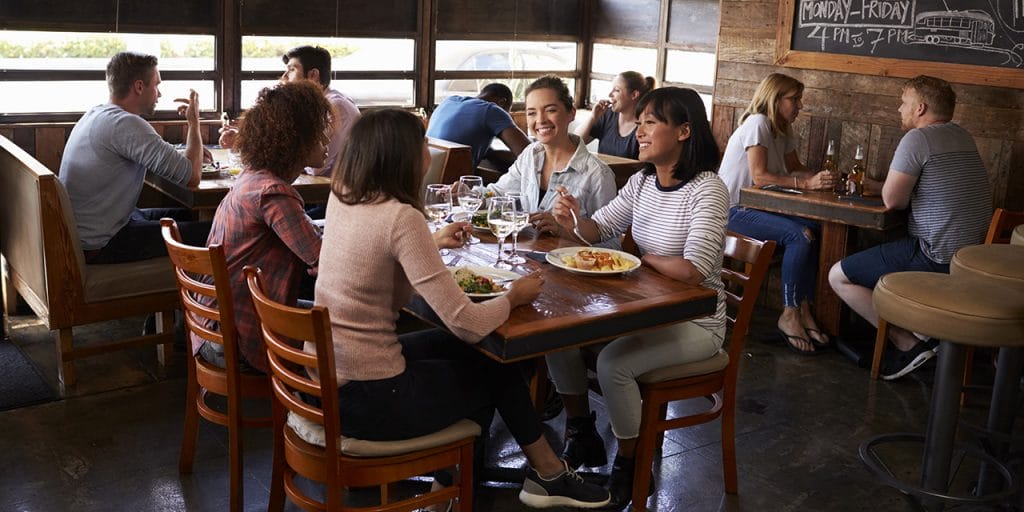
Lunch hours can also draw families and casual diners. That said, ensuring a streamlined ordering and serving process can make a big difference in customer satisfaction and turnover rates.
Dinner: The Main Event
Dinner time is the peak time for most restaurants. It typically lasts from 5:00 p.m. to 9:00 p.m.
Families, couples and groups often dine out after the day, making this the busiest part of the day for both casual and upscale restaurants.
This is when staffing and kitchen efficiency matter most. Having clear workflows and a well-trained team ensures customers get a timely and enjoyable experience.
Take Your Restaurant Operations to the Next Level With OysterLink
Here at OysterLink, we provide valuable insights, expert advice and industry resources to help you streamline operations, boost efficiency and enhance the overall dining experience.
If you need help improving customer satisfaction, optimizing staff management or increasing profitability, check out our articles below:
Time Management for a Busy Restaurant: FAQs
The busiest days for most restaurants are Friday through Sunday. It typically starts Friday evening as people celebrate the end of the workweek and continues into Saturday and Sunday, when brunch, lunch and family gatherings bring steady traffic.
Between 5:00 p.m. and 9:00 p.m. This period draws families, couples and groups looking to dine out and order delivery. This makes this time frame the peak service time for both casual and upscale establishments.
Mondays and Tuesdays are usually the slowest days for restaurants. The reason for this is that many diners prefer to stay home after the weekend. Mid-mornings (8 a.m. to 10 a.m.) and early afternoons (3 p.m. to 5 p.m.) during weekdays can also be quieter, especially outside of lunch rush hours.

Written by Mitko Terziev
With over eight years of experience in the field, Mitko is a seasoned content specialist who has penned thousands of articles covering a wide array of topics. Before writing, he spent a few months working as a Bartender in one of the best bars in his hometown. In his free time, Mitko enjoys immersing himself in the worlds of gaming and nature.

Reviewed by Marcy Miniano
Marcy is an editor and writer with a background in public relations and brand marketing. Throughout her nearly decade-long career, she has honed her skills in crafting content and helping build brands across various industries — including restaurant and hospitality, travel, tech, fashion and entertainment.





